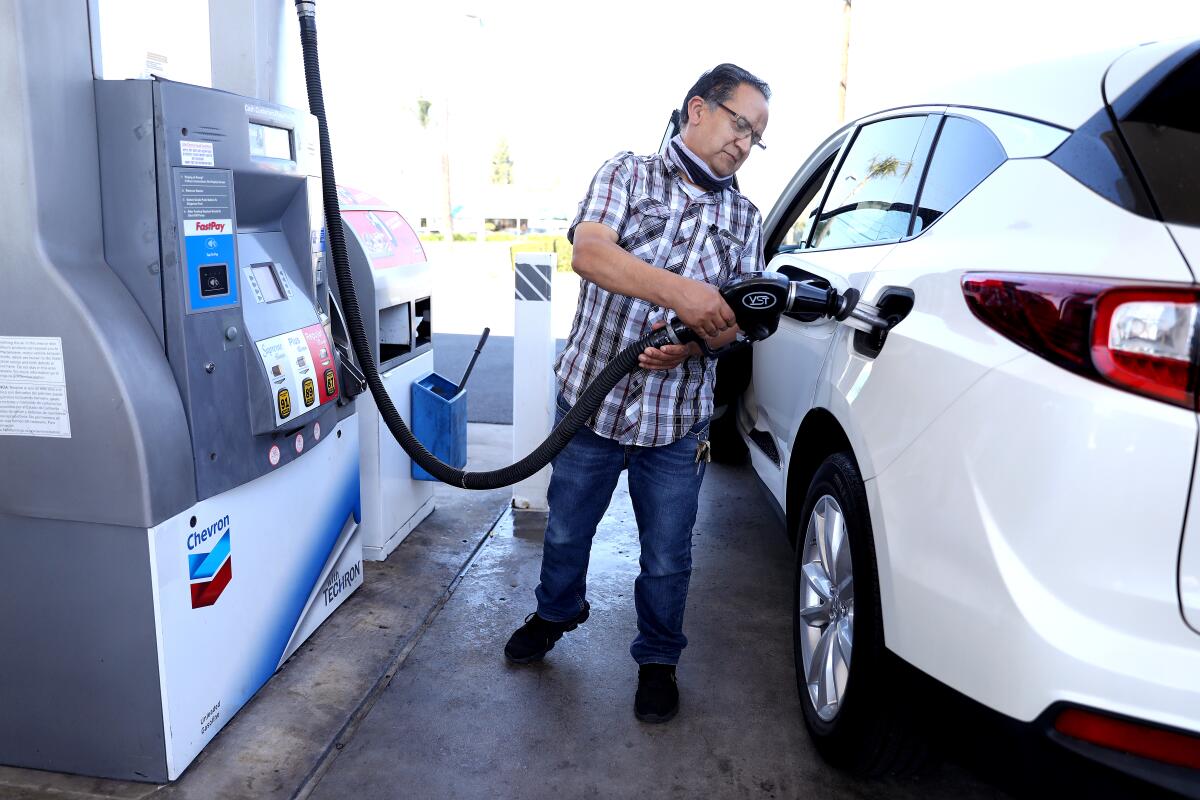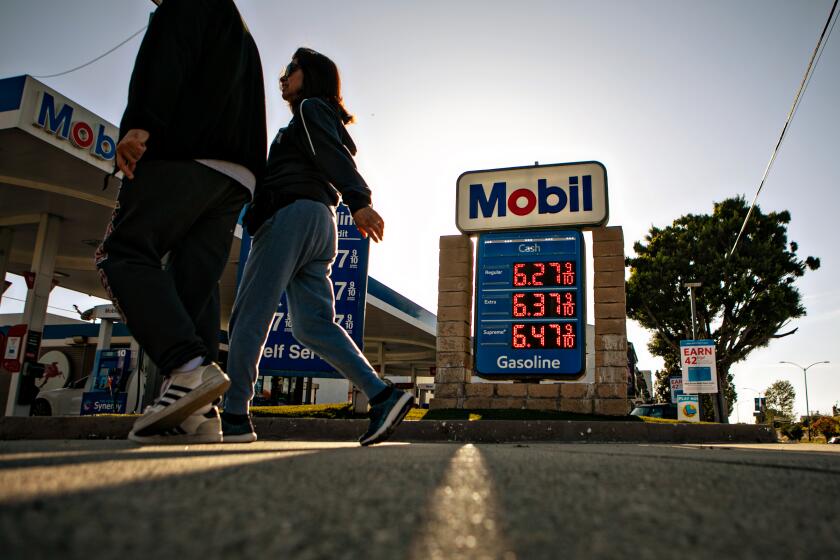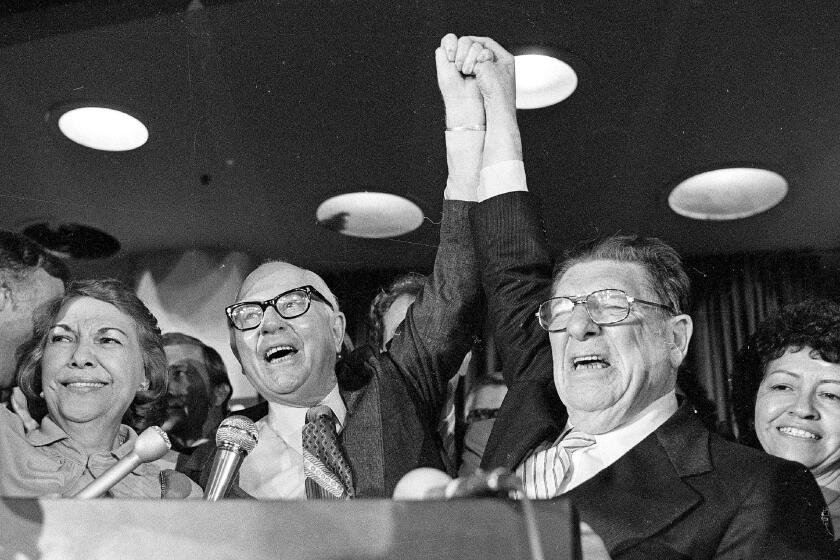Newsom, lawmakers haggle over plan for relief from California’s high gas prices

- Share via
SACRAMENTO — More than a month after Gov. Gavin Newsom pledged to give Californians money to offset rising gas prices, he and state lawmakers have yet to find common ground on the most basic details of the plan: Who should be eligible for refunds and how much should they receive?
The governor and legislators also disagree on big-picture questions of how much of California’s record tax revenues should be sent back to residents and where refunds should fall in the hierarchy of other needs in the state.
“It’s definitely not a lack of attention and work,” said Senate President Pro Tem Toni Atkins (D-San Diego) about the slow-going negotiations. “It is more really trying to land on the spot that we feel is appropriate. On our side, there’s just not a lot of interest in providing checks to the wealthiest of Californians.”
Gas prices in the state are beginning to drop from highs this year, but the $5.73 average price of a gallon of regular unleaded fuel remains $1.79 higher than what Californians paid at the pump one year ago and $1.65 above the current national average, according to American Automobile Assn. data as of Wednesday.
With higher transportation costs increasing the price of food and other goods, state leaders hope to reach an agreement soon and get funds out the door to residents this summer. Yet little progress had been made by the time the Legislature broke for its spring recess last week.
The plan Newsom proposed last month would give at least one $400 refund to each registered vehicle owner in the state, regardless of income. Refunds would be capped at $800 for anyone with more than one vehicle registered under their name.
His office also released proposed legislative language last week on a package of fuel price relief bills that includes $750 million in grants to public transit agencies to offer free fares for three months, elimination of the sales tax on diesel fuel for a year, and pausing an increase in the excise tax on fuel that is scheduled to take place in July.
But Newsom’s proposal raises equity concerns for Democratic legislators, who say they can’t justify sending money back to the highest earners while omitting some of the poorest. Californians in households without cars were more than twice as likely to live in poverty compared to those with cars in 2019, according to an analysis by the California Budget & Policy Center, a nonprofit that advocates for programs benefiting low-income residents.
That question is at the center of ongoing discussions inside the state Capitol as California grapples with a surge in gasoline costs and is projected to have a record-high budget and surplus.
“My wife and I don’t need additional money, but folks who are struggling in lower-income brackets should get a little bit more,” said Assembly Speaker Anthony Rendon (D-Lakewood).
H.D. Palmer, a spokesman for the governor’s budget office, said Newsom’s proposal prioritizes drivers at all income levels and excludes those without cars from receiving refunds because it’s a direct response to gasoline prices.
“The focus of the governor’s proposal has been on people who are paying at a pump,” Palmer said.
He said one way to limit refunds for drivers is to cut off payments for those with high-value vehicles who pay above a yet-to-be-determined amount in license fees. Vehicle license fees in California are included in annual registration fees and calculated based on the car’s purchase price or value.
All told, Newsom’s office projects the governor’s plan would cost more than $11 billion if it includes refunds for all vehicle owners.
California is among several states considering tax relief as gas prices and inflation drive up the cost of living. Lawmakers in New Mexico approved income tax rebates of $500 for joint households with annual income under $150,000 and $250 for single filers with income under $75,000. Other states, such as New York and Florida, plan to temporarily eliminate gas taxes.
Although economists debate the benefits of sending one-time checks to taxpayers, tax refunds tend to be popular in election years. Newsom championed the Golden State Stimulus last year in response to the economic effects of the COVID-19 pandemic, with the first $600 batch of checks delivered to Californians two weeks ahead of the Sept. 14 recall election.
Talk of refund proposals was inspired, in part, by the likelihood that California’s tax revenues will exceed the state‘s constitutional appropriations limit and trigger restrictions on how lawmakers spend excess revenues.
Under the 1979 law, legislators could reduce revenues and avoid hitting the appropriations limit by giving money back to Californians through rebates or the expansion of tax credits, or by increasing funding for local governments, infrastructure projects or state emergencies, according to a report by the independent Legislative Analyst’s Office. If no action is taken and revenues exceed the threshold over a two-year period, excess cash would have to be split between schools and taxpayer rebates.
Anti-tax activist Paul Gann’s 1979 ballot measure to limit state spending, a follow-up to Proposition 13, may be more relevant now than ever.
At the crux of debate among Democratic legislators is whether a portion of the money proposed for refunds would be better spent on other needs. Atkins and Rendon introduced their own plan last month that they said would cost significantly less than Newsom’s at about $6.8 billion and not hinge on vehicle ownership.
The legislative leaders instead support broader-based refunds through $200 payments for each California taxpayer and dependent. Eligibility would be limited to individuals who earn as much as $125,000 a year or households with a taxable annual income of up to $250,000.
State Sen. Ben Allen (D-Santa Monica) is among a contingent of lawmakers who would prefer to offer a more limited tax refund than either Newsom or legislative leaders have proposed and instead target the payments to low-income Californians, leaving more money left over for infrastructure projects. Allen suggested funding improvements to school facilities, new housing for homeless people, better access to clean water, enhancing the transportation system and other pressing problems.
“I think that we would be making a mistake if we weren’t considering the very substantial infrastructural needs of our state in this conversation,” Allen said. “California’s infrastructure is creaking and part of our ability to remain competitive as a state and as an economy will involve ensuring that we’ve got the infrastructure to take our economy to the next level and quality of life to the next level.”
He also said the state should be tucking away more money now for a future recession. Fears of an economic downturn are growing as rates and the cost of borrowing money increase in the U.S.
“There’s so much desire to spend money and rebate money and all of that but I know that this flush budgetary moment is very temporary and we will regret not being more cautious if we go ahead with all the plans that various folks have put forward,” he said.
Atkins said she anticipates a final deal will include both targeted refunds and money for the kinds of investments Allen and others are pushing. Palmer said Newsom hopes to sign gas relief legislation before unveiling a revised version of his state budget in mid-May.
“I would have liked to have seen us come to some agreement sooner, but I understand why it hasn’t happened,” Atkins said, adding that she’s speaking with Rendon and Newsom together this week. “I hope we can get this done quickly.”
More to Read
Sign up for Essential California
The most important California stories and recommendations in your inbox every morning.
You may occasionally receive promotional content from the Los Angeles Times.
















